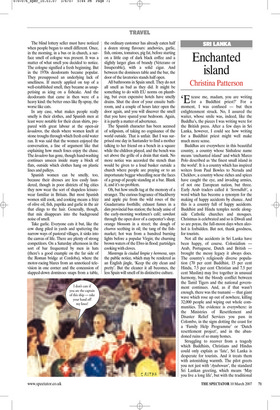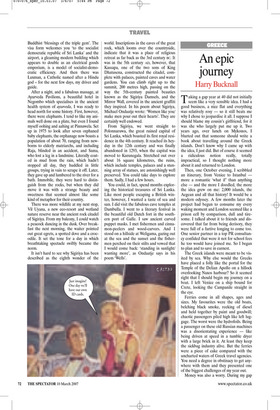Enchanted island
Christina Patterson
‘Excuse me, madam, you are writing for a Buddhist priest?’ For a moment, I was confused — but then enlightenment struck. No, I assured the waiter, whose smile was, indeed, like the Buddha’s, the pieces I was writing were for the British press. After a few days in Sri Lanka, however, I could see how writing for a Buddhist priest might well make much more sense.
Buddhas are everywhere in this beautiful country, a country whose Sinhalese name means ‘enchanted island’ and which Marco Polo described as ‘the finest small island in the world’. It is a country which has inspired writers from Paul Bowles to Neruda and Chekhov, a country whose riches and spices have caught the eye, and invading armies, of not one European nation, but three. Early Arab traders called it ‘Serendhib’, a word which has become a synonym for the making of happy accidents by chance. And this is a country full of happy accidents. Buddhist and Hindu temples nestle alongside Catholic churches and mosques. Christmas is celebrated and so is Diwali and so are poyas, the full-moon days when alcohol is forbidden. But not, thank goodness, for tourists.
Not all the accidents in Sri Lanka have been happy, of course. Colonialism Arab, Portuguese, Dutch and British brought the messy legacy it always does. The country’s religiously diverse population (70 per cent Buddhist, 15 per cent Hindu, 7.5 per cent Christian and 7.5 per cent Muslim) may live together in unusual harmony, but the bloody conflict between the Tamil Tigers and the national government continues. And, as if that wasn’t enough, there was the tsunami — that giant wave which rose up out of nowhere, killing 32,000 people and wiping out whole communities. The evidence is everywhere: in the Ministries of Resettlement and Disaster Relief Services you pass in Colombo, in the signs dotting the coast for a ‘Family Help Programme’ or ‘Dutch resettlement project’, and in the abandoned ruins of so many homes.
Struggling to recover from a tragedy which Buddhists, Christians and Hindus could only explain as ‘fate’, Sri Lanka is desperate for tourists. And it treats them with astonishing warmth. The pilot greets you not just with ‘Ayubowan’, the standard Sri Lankan greeting, which means ‘May you live a long life’, but with the traditional Buddhist ‘blessings of the triple gem’. The visa form welcomes you ‘to the socialist democratic republic of Sri Lanka’ and the airport, a gleaming modern building which appears to double as an electrical goods emporium, is a model of socialist-democratic efficiency. And then there was Luxman, a Catholic named after a Hindu god – for the next few days, my driver and guide.
After a night, and a fabulous massage, at Ayurveda Pavilions, a beautiful hotel in Negombo which specialises in the ancient health system of ayurveda, I was ready to head north for some history. First, however, there were elephants. I tend to like my animals well done on a plate, but even I found myself oohing and aahing at Pinnawela. Set up in 1975 to look after seven orphaned baby elephants, the orphanage now boasts a population of about 70, ranging from newborns to elderly matriarchs, and including Raja, blinded in an accident, and Sama, who lost a leg in a landmine. Literally coated in mud from the rain, which hadn’t stopped all day, they huddled in little groups, trying in vain to scrape it off. Later, they gave up and lumbered to the river for a bath. Immobile, they were hard to distinguish from the rocks, but when they did move it was with a strange beauty and sweetness that seemed almost like some kind of metaphor for their country.
There was more wildlife at my next stop, Vil Uyana, a new eco-resort and wetland nature reserve near the ancient rock citadel of Sigiriya. From my balcony, I could watch a peacock dancing in the dusk. Over breakfast the next morning, the waiter pointed out great egrets, a spotted dove and a crocodile. It set the tone for a day in which breathtaking spectacle swiftly became the norm.
It isn’t hard to see why Sigiriya has been described as the eighth wonder of the world. Inscriptions in the caves of the great rock, which looms over the countryside, indicate that it was a place of religious retreat as far back as the 3rd century BC. It was in the 5th century AD, however, that Kassapa, one of the two sons of King Dhatusena, constructed the citadel, complete with palaces, painted caves and water gardens. You can climb right up to the summit, 200 metres high, passing on the way the 5th-century painted beauties known as the Sigiriya Damsels, and the Mirror Wall, covered in the ancient graffiti they inspired. In his poem about Sigiriya, Michael Ondaatje wrote: ‘Women like you/ make men pour out their hearts’. They are certainly well endowed.
From Sigiriya, we went straight to Polonnaruwa, the great ruined capital of Sri Lanka, which boasted its first royal residence in the 4th century. It reached its heyday in the 12th century and was finally abandoned in 1293, when the capital was moved to Kurunegala. Stretched out over about 16 square kilometres, the ruins, which include temples, palaces and a stunning array of statues, are astonishingly well preserved. You could take days to explore them. Sadly, I had a few hours.
You could, in fact, spend months exploring the historical treasures of Sri Lanka. Like most people escaping a British winter, however, I wanted a taste of sea and sun. I did visit the fabulous cave temples at Dambulla. I went to a literary festival in the beautiful old Dutch fort in the southern port of Galle. I saw ancient carved puppet masks. I met fishermen and cinnamon-peelers and wood-carvers. And I stood on a hillside at Weligama, gazing out at the sea and the sunset and the fishermen perched on their stilts and vowed that I would come back: ‘standing in sunlight/ wanting more’, as Ondaatje says in his poem ‘Wells’.



























































































 Previous page
Previous page